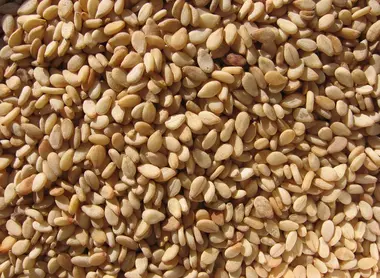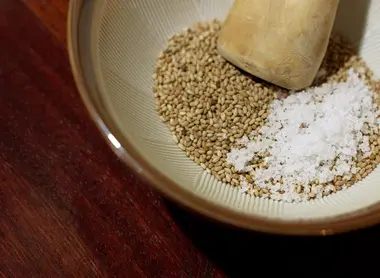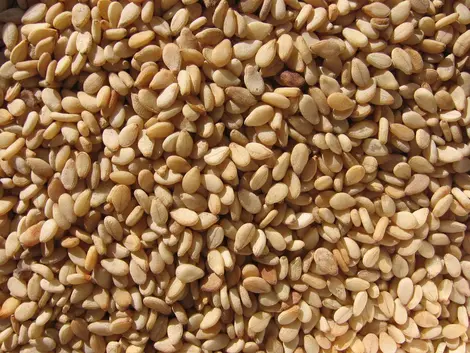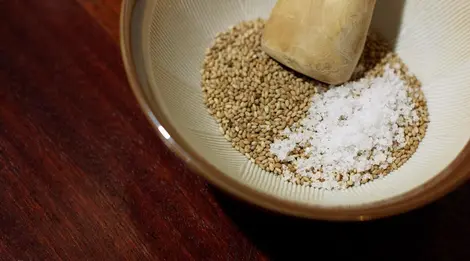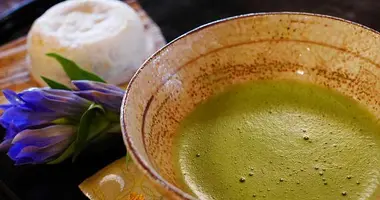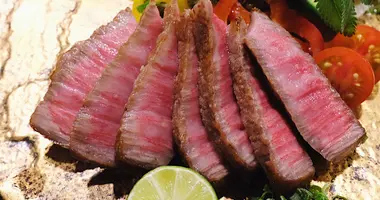Sesame in Japanese cuisine
- Published on : 30/11/2017
- by : A.R.
- Youtube
Japan's many uses for sesame
The Japanese are the largest consumers of sesame, with nearly 160,000 tonnes imported each year from Latin America. And with good reason - in Japanese cuisine, sesame features in a variety of delicious ways!
First, let's distinguish the three main types of sesame (胡麻, goma in Japanese): white sesame, the most common, black sesame, and finally golden sesame. These three sesame types are used in abundance in Japanese cooking, usually not for their nutritional quality - although sesame seeds are full of fibers and minerals - and instead for their taste. But these seeds are far from interchangeable.
TYPES OF SESAME
- White sesame 白胡麻
The various sesame seeds are used in different ways. White sesame is the most subtle in taste, so it's generally the most popular. It is used in Japanese salad dressings, or for sesame tofu, or "shira-ae" (a Japanese crushed tofu salad with crunchy vegetables). Finally, its light taste makes it the perfect garnish, adding visual interest without altering the taste of the dish!
Read: The art of bento
- Black sesame 黒胡麻
As for black sesame, it has a much more distinctive, nutty taste, so it is the preferred type of sesame for marinades, and also for seasoning rice porridge. It can also be crushed to make a paste, which is often used in Japanese cuisine: to decorate dishes or salads, or even for a good sandwich! It's also used to make desserts: black sesame pudding, ice cream, cookies and more.
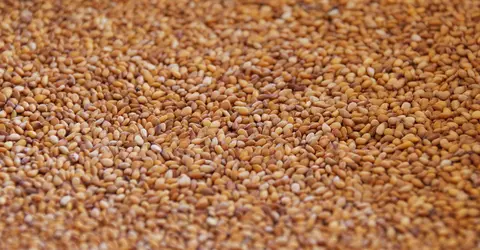
White sesame grains
- Golden sesame 金胡麻
Golden sesame is the least well-known, and is found mainly in furikake, mixtures of sesame and nori seaweed, ground to a powder and used to season rice. Furikake are very popular, especially with children. There are many variants (fish, egg, vegetable...), which you will find in all Japanese supermarkets. Furikake is often sold in individual portions, with very colorful packaging!
Black and golden sesame seeds are also often roasted, then crushed and mixed with salt to create goma shio, a popular condiment in Japan. You will find goma shio in many Japanese restaurants, including ramen shops, between the ginger and soy sauce.
Read: Soya in Japanese cuisine
- Sesame oil
Finally, what would Japanese cuisine be without sesame oil? This is the base of multiple recipes. There is a slightly spicy version sold that subtly enhances the dishes it's used in.
Sesame isn't the first ingredient that comes to mind when thinking of Japanese cuisine. However once you're there it's impossible to miss it, and once you've tried it, it's difficult to do without!
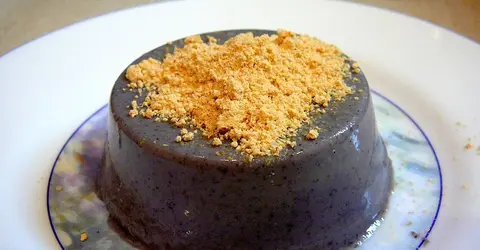
Black sesame pudding
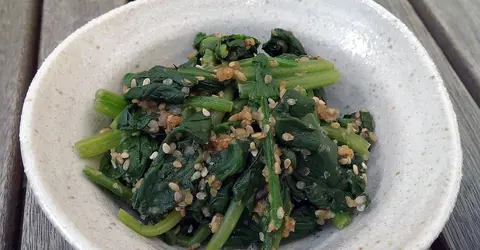
spinach 'goma-ae', spinach with a sesame dressing
Bienfaits nutritionnels et vertus du sésame
Le sésame n'est pas seulement apprécié pour ses qualités gustatives, mais aussi pour ses nombreux bienfaits nutritionnels. Voici un aperçu des vertus de cette graine miraculeuse :
1. Richesse en nutriments :
- Protéines : Le sésame est une excellente source de protéines végétales, avec environ 20% de sa composition.
- Fibres : Riches en fibres, les graines de sésame favorisent une bonne digestion et contribuent à la satiété.
- Minéraux : Particulièrement riche en calcium, fer, magnésium, phosphore, zinc et cuivre.
- Vitamines : Contient des vitamines B (notamment B1, B6 et B9) et de la vitamine E.
2. Propriétés antioxydantes :
- Le sésame est riche en lignanes, des composés phytochimiques aux puissantes propriétés antioxydantes.
- La sésamine, principal lignane du sésame, contribue à la protection cellulaire contre les dommages oxydatifs.
3. Bienfaits cardiovasculaires :
- Les acides gras insaturés du sésame contribuent à maintenir un bon taux de cholestérol.
- La consommation régulière de sésame peut aider à réguler la pression artérielle.
4. Santé osseuse :
- Grâce à sa haute teneur en calcium et en magnésium, le sésame contribue à la santé des os et des dents.
- Il peut aider à prévenir l'ostéoporose, en particulier chez les personnes âgées.
5. Régulation du diabète :
- Le sésame a un index glycémique bas, ce qui en fait un aliment intéressant pour les personnes diabétiques.
- Il peut aider à stabiliser la glycémie et à améliorer la sensibilité à l'insuline.
6. Propriétés anti-inflammatoires :
- Les composés du sésame peuvent aider à réduire l'inflammation chronique dans l'organisme.
- Cela peut être bénéfique pour les personnes souffrant de maladies inflammatoires comme l'arthrite.
7. Santé digestive :
- Les fibres du sésame favorisent un transit intestinal régulier.
- Elles contribuent également à maintenir une flore intestinale saine.
Ces nombreux bienfaits font du sésame un véritable superaliment. Son intégration régulière dans l'alimentation, comme c'est le cas dans la cuisine japonaise, peut contribuer à une meilleure santé globale. Cependant, comme pour tout aliment, il est important de le consommer avec modération dans le cadre d'une alimentation équilibrée.
Le sésame dans la pâtisserie et les desserts japonais
Bien que souvent associé aux plats salés, le sésame joue également un rôle important dans la pâtisserie et les desserts japonais. Sa saveur unique et sa polyvalence en font un ingrédient apprécié pour créer des douceurs originales et savoureuses. Voici quelques exemples de l'utilisation du sésame dans les desserts japonais :
1. Glace au sésame noir (Kuro goma aisu) :
- Une glace crémeuse au goût intense de sésame noir, souvent servie dans les restaurants japonais.
- Sa couleur gris foncé et son goût unique en font un dessert très populaire.
2. Pudding au sésame noir (Kuro goma purin) :
- Un flan doux et onctueux parfumé au sésame noir.
- Souvent servi avec un sirop de kuromitsu (mélasse d'Okinawa) pour un contraste de saveurs.
3. Daifuku au sésame :
- Ces gâteaux de riz gluant sont parfois remplis de pâte de sésame noir sucrée.
- La texture moelleuse du mochi contraste agréablement avec la richesse du sésame.
4. Cookies au sésame :
- Des biscuits croquants parsemés de graines de sésame ou aromatisés à l'huile de sésame.
- Populaires comme snack ou accompagnement du thé.
5. Gâteau roulé au sésame (Goma roll cake) :
- Un gâteau éponge léger parfumé au sésame, roulé avec une crème au sésame.
- Un dessert élégant qui met en valeur la subtilité du sésame.
6. Dango au sésame :
- Ces boulettes de riz gluant sont parfois enrobées de pâte de sésame sucrée.
- Un snack traditionnel apprécié lors des festivals.
7. Mochi au sésame noir :
- Des gâteaux de riz gluant aromatisés au sésame noir, souvent fourrés de pâte de haricot rouge sucrée.
- La combinaison du sésame et du haricot rouge crée un équilibre de saveurs typiquement japonais.
8. Crème brûlée au sésame :
- Une version japonaise de ce dessert classique, parfumée au sésame.
- La caramélisation du sucre en surface crée un contraste intéressant avec la saveur du sésame.
L'utilisation du sésame dans les desserts japonais démontre la versatilité de cet ingrédient et la créativité des pâtissiers nippons. Ces desserts offrent souvent un équilibre subtil entre douceur et complexité, typique de la pâtisserie japonaise. Ils permettent également d'apprécier le sésame sous un angle différent, révélant sa capacité à s'adapter aussi bien aux plats salés que sucrés.
Pour découvrir ces saveurs uniques et vous initier à la pâtisserie japonaise, pourquoi ne pas essayer de préparer l'un de ces desserts chez vous ? Ou mieux encore, participez à Cuisine à la maison avec Akiko lors de votre prochain voyage à Tokyo. C'est une excellente façon de s'immerger dans la culture culinaire japonaise et de découvrir les secrets de l'utilisation du sésame dans toute sa diversité.
N'hésitez pas à explorer d'autres Activités à Tokyo pour approfondir votre connaissance de la cuisine japonaise et de ses ingrédients emblématiques comme le sésame.
